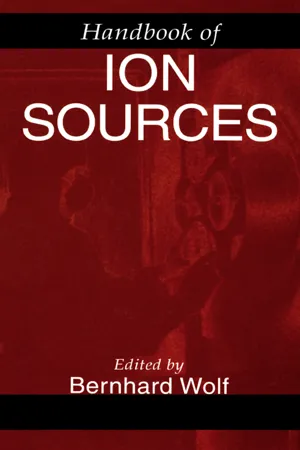![]()
Chapter 1
FUNDAMENTAL PROCESSES
Ian Brown
CONTENTS
1. Introduction
2. Basic Plasma Parameters
2.1 Plasma Density, Degree of Ionization, and Temperature
2.2 Distribution Functions; Means
2.3 Collisions
2.4 Plasma Frequency
3. Ionization Phenomena
3.1 Electron Impact Ionization
3.2 Multiple Electron Removal; Single-Step and Multistep Ionization
3.3 Surface Ionization
3.4 Field Ionization
3.5 Ion Impact Ionization
3.6 Photoionization
3.7 Negative Ions
4. The Plasma Boundary
5. Magnetic Field Effects
5.1 Gyromotion
5.2 Magnetic Confinement
5.3 Magnetic and Plasma Pressure
References
1 INTRODUCTION
The plasma state is the fourth state of matter, following the solid, liquid, and gaseous states. This common description of plasma refers to its energy content — as the temperature of a substance is increased, the material changes first from solid to liquid, then liquid to gas, and finally from gas to plasma. In a plasma, some of the orbital electrons are stripped from their nuclei and are free to participate as individual particles. While in a gas the individual particles are molecules of the gas species (or atoms, for the noble gases), in a plasma the individual particles that make up the plasma are, in general, three different kinds — ions, electrons, and neutrals. Because some of the particles are now charged, as opposed to the neutral particles of an ordinary gas, the kinds of interactions that can take place between the particles, and between the plasma as a whole and external fields, are much more diverse than for the gaseous state.
Plasmas exist in nature in those environments where the temperature is adequately high, such as in the sun, stars and in the ionosphere, and on the earth in transient forms such as lightning. Man-made plasmas have become commonplace and are part of the modern world in forms such as fluorescent lamps, neon signs, and high-voltage sparks. Laboratory plasmas can be created in a wide variety of ways, most commonly as electrical discharges of one kind or another. Industrially, plasmas are used in various forms for semiconductor processing, materials modification and synthesis, and other purposes. In the 1970s and 1980s the controlled-fusion research programs in many countries around the world dominated the plasma physics research scene internationally. In ion sources, plasmas are the medium from which the ions are extracted.
Here we survey and summarize the basic parameters and characteristics of the plasma medium. Particle density and temperature are defined and related to some of the different kinds of plasmas encountered in ion sources. Ionization phenomena — the ways in which the ionized plasma may be formed from the neutral medium — are discussed next. Finally, we summarize some of the characteristics of the plasma boundary and plasma behavior in magnetic fields. The presentation is condensed; for more detail than is presented here the reader might consult any of a number of excellent texts on the subject (e.g., References 1 to 7). The review presented here is limited to those parts of the very broad field of plasma physics that are important for an understanding of ion source fundamentals.
2 BASIC PLASMA PARAMETERS
2.1 Plasma Density, Degree of Ionization, and Temperature
In the simplest case a plasma contains positively charged ions and negatively charged electrons. The ion density, particles per centimeter cubed or per meter cubed, is commonly given the symbol ni and the electron density ne. If the ions are all singly ionized, qi= +1, and because the plasma is overall charge-neutral, the ion density equals the electron density, ni=ne. In the more general case the plasma may contain multiply charged ions, say qi = 1+, 2+,…, or even negatively charged ions, qi = −1, and there may also be neutral particles of density nn; then the ion and electron particle densities need not be the same. Charge neutrality is still preserved, however, as expressed by the general condition
The term plasma density is often used to mean the ion density or electron density of the plasma, but note that the term is ill-defined except for the case of a plasma of singly charged positive ions. A more precise way of describing the plasma particle density is to specify the electron density and the distribution of ion charge states.
The fractional ionization or percentage ionization of the plasma is defined as the ratio of ion density to total density of ions and neutral particles,
| (2) |
If there are no neutral particles in the plasma then the plasma is said to be fully ionized; the term highly ionized is loosely used to describe plasmas with percentage ionization greater than about 10% or so. Confusion often occurs with the use of the term highly ionized, since it can be used to refer either to a plasma with a high-percentage ionization or to ions that have several electrons removed. The solution is to be aware of this possibility and to use other terminology. The latter might be referred to, for example, as highly stripped or multiply ionized.
Most plasmas encountered in the laboratory, especially in ion source applications, have densities in the broad range of 1010 to 1014 cm−3. More commonly, because of the conditions imposed on the ion source plasma for good beam formation (good ion...
